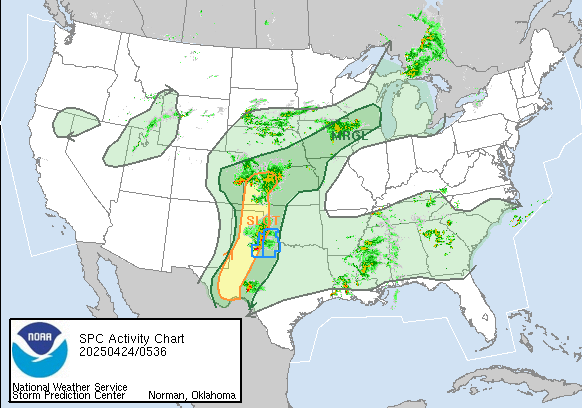SPC AC 210514
Day 1 Convective Outlook
NWS Storm Prediction Center Norman OK
1114 PM CST Sat Dec 20 2025
Valid 211200Z - 221200Z
...NO SEVERE THUNDERSTORM AREAS FORECAST...
...SUMMARY...
Severe thunderstorms are not expected today.
...Pacific Northwest...
Low-amplitude short-wave trough is forecast to approach the Pacific
Northwest coast later this evening as modest midlevel height falls
spread inland across WA/OR. Latest model guidance suggests weak
buoyancy will persist much of the period, particularly near the
coast, where onshore flow will contribute to SBCAPE generally less
than 100 J/kg. As freezing levels lower, shallow convection may
penetrate levels necessary for lightning discharge. For these
reasons will maintain 10% probability for isolated thunderstorms,
primarily near the coast.
..Darrow/Squitieri.. 12/21/2025
NOTE: THE NEXT DAY 1 OUTLOOK IS SCHEDULED BY 1300Z
SPC AC 210635
Day 2 Convective Outlook
NWS Storm Prediction Center Norman OK
1235 AM CST Sun Dec 21 2025
Valid 221200Z - 231200Z
...NO SEVERE THUNDERSTORM AREAS FORECAST...
...SUMMARY...
Severe thunderstorms are not forecast on Monday.
...Synopsis...
Model guidance continues to show an upper-level ridge and quiescent
conditions influencing weather across much of Lower 48 states on
Monday. A mid-level shortwave trough will move from the eastern
Pacific into WA and British Columbia during the period.
Increasingly cool mid-level temperatures will support pockets of
scant instability near the Pacific Northwest coast. Widely
scattered showers and perhaps a few low-topped thunderstorms may
develop along the immediate coast. Farther southeast along the
lower coast of TX within a seasonably moist airmass, weak convection
may develop but negligible forcing will likely limit convective
potential with this activity.
..Smith.. 12/21/2025
WUUS02 PTSDY2
SPC AC 210809
Day 3 Convective Outlook
NWS Storm Prediction Center Norman OK
0209 AM CST Sun Dec 21 2025
Valid 231200Z - 241200Z
...NO SEVERE THUNDERSTORM AREAS FORECAST...
...SUMMARY...
Severe thunderstorms are not forecast across the contiguous United
States on Tuesday or Tuesday night.
...Synopsis...
A dominant mid- to upper-level ridge will remain steadfast across
central portion of the Lower 48 states. An upper trough will
encroach on the West Coast, and a lead mid-level trough will move
quickly northeast from the eastern Pacific into the northern CA
coastal area late Tuesday night. Scant to weak buoyancy will
gradually develop Tuesday night in the vicinity of the CA coast and
coastal range from near Point Conception to near the OR border.
Scattered showers and isolated thunderstorms will gradually spread
inland concurrent with increasing large-scale forcing and
instability. Some forecast soundings depict a deep,
lower-tropospheric moist layer co-located with intense low-level
shear, which could imply storm organization being possible with the
strongest low-topped storms. Uncertainty is high at this time for
such a scenario given appreciable model variability. Farther east,
a weak upper trough near the lower Rio Grande Valley will undercut a
mid- to upper-level ridge over the central US. Weak convection is
possible in association with this upper feature, but confidence in
attaining 10-percent thunderstorm probabilities is low at this time.
..Smith.. 12/21/2025
WUUS03 PTSDY3
NOTE: THE NEXT DAY 3 OUTLOOK IS SCHEDULED BY 1930Z
| 





